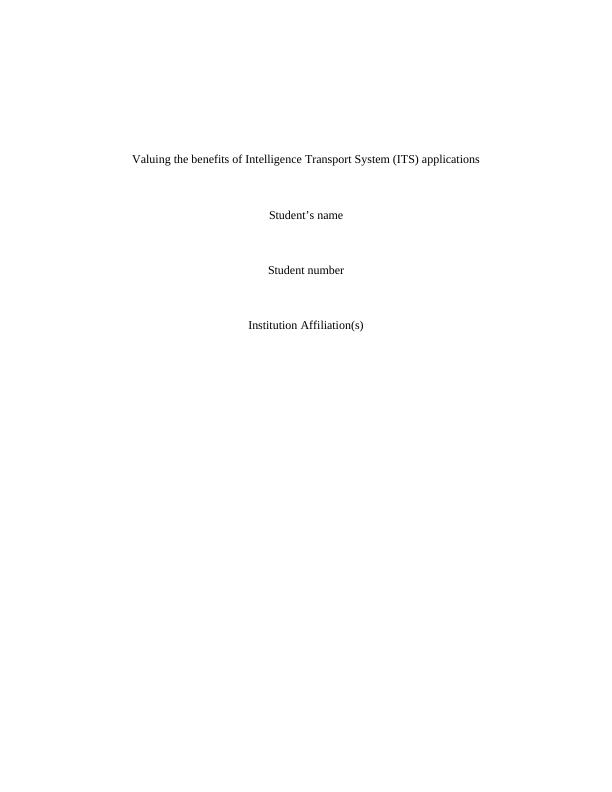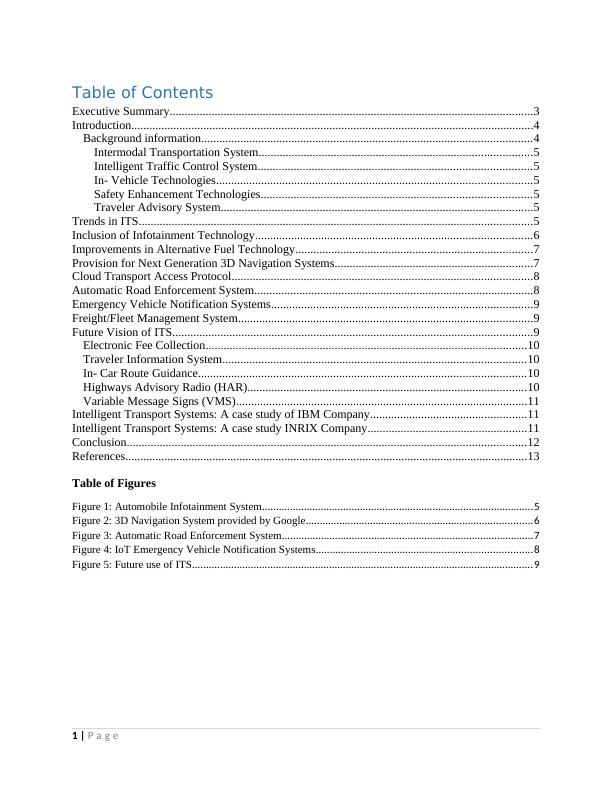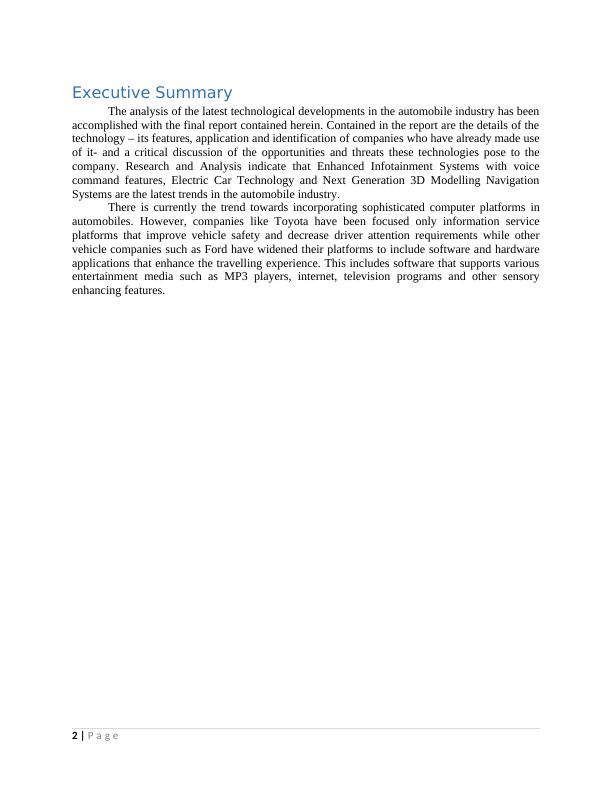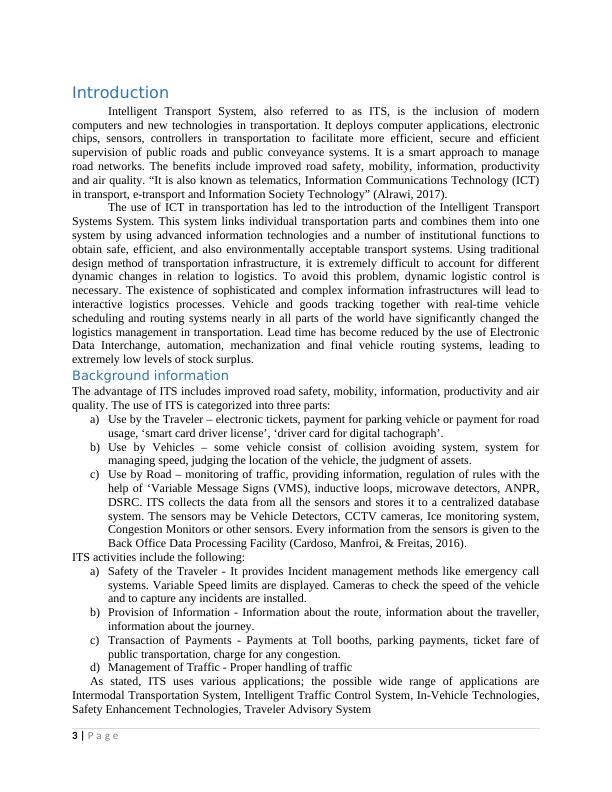Valuing the Benefits of Intelligent Transport System (ITS) Applications
Added on 2023-03-20
14 Pages5388 Words25 Views
Valuing the benefits of Intelligence Transport System (ITS) applications
Student’s name
Student number
Institution Affiliation(s)
Student’s name
Student number
Institution Affiliation(s)

Table of Contents
Executive Summary.........................................................................................................................3
Introduction......................................................................................................................................4
Background information..............................................................................................................4
Intermodal Transportation System...........................................................................................5
Intelligent Traffic Control System...........................................................................................5
In- Vehicle Technologies.........................................................................................................5
Safety Enhancement Technologies..........................................................................................5
Traveler Advisory System........................................................................................................5
Trends in ITS...................................................................................................................................5
Inclusion of Infotainment Technology............................................................................................6
Improvements in Alternative Fuel Technology...............................................................................7
Provision for Next Generation 3D Navigation Systems..................................................................7
Cloud Transport Access Protocol....................................................................................................8
Automatic Road Enforcement System.............................................................................................8
Emergency Vehicle Notification Systems.......................................................................................9
Freight/Fleet Management System..................................................................................................9
Future Vision of ITS........................................................................................................................9
Electronic Fee Collection...........................................................................................................10
Traveler Information System.....................................................................................................10
In- Car Route Guidance.............................................................................................................10
Highways Advisory Radio (HAR).............................................................................................10
Variable Message Signs (VMS).................................................................................................11
Intelligent Transport Systems: A case study of IBM Company....................................................11
Intelligent Transport Systems: A case study INRIX Company.....................................................11
Conclusion.....................................................................................................................................12
References......................................................................................................................................13
Table of Figures
Figure 1: Automobile Infotainment System.................................................................................................5
Figure 2: 3D Navigation System provided by Google.................................................................................6
Figure 3: Automatic Road Enforcement System..........................................................................................7
Figure 4: IoT Emergency Vehicle Notification Systems.............................................................................8
Figure 5: Future use of ITS..........................................................................................................................9
1 | P a g e
Executive Summary.........................................................................................................................3
Introduction......................................................................................................................................4
Background information..............................................................................................................4
Intermodal Transportation System...........................................................................................5
Intelligent Traffic Control System...........................................................................................5
In- Vehicle Technologies.........................................................................................................5
Safety Enhancement Technologies..........................................................................................5
Traveler Advisory System........................................................................................................5
Trends in ITS...................................................................................................................................5
Inclusion of Infotainment Technology............................................................................................6
Improvements in Alternative Fuel Technology...............................................................................7
Provision for Next Generation 3D Navigation Systems..................................................................7
Cloud Transport Access Protocol....................................................................................................8
Automatic Road Enforcement System.............................................................................................8
Emergency Vehicle Notification Systems.......................................................................................9
Freight/Fleet Management System..................................................................................................9
Future Vision of ITS........................................................................................................................9
Electronic Fee Collection...........................................................................................................10
Traveler Information System.....................................................................................................10
In- Car Route Guidance.............................................................................................................10
Highways Advisory Radio (HAR).............................................................................................10
Variable Message Signs (VMS).................................................................................................11
Intelligent Transport Systems: A case study of IBM Company....................................................11
Intelligent Transport Systems: A case study INRIX Company.....................................................11
Conclusion.....................................................................................................................................12
References......................................................................................................................................13
Table of Figures
Figure 1: Automobile Infotainment System.................................................................................................5
Figure 2: 3D Navigation System provided by Google.................................................................................6
Figure 3: Automatic Road Enforcement System..........................................................................................7
Figure 4: IoT Emergency Vehicle Notification Systems.............................................................................8
Figure 5: Future use of ITS..........................................................................................................................9
1 | P a g e

Executive Summary
The analysis of the latest technological developments in the automobile industry has been
accomplished with the final report contained herein. Contained in the report are the details of the
technology – its features, application and identification of companies who have already made use
of it- and a critical discussion of the opportunities and threats these technologies pose to the
company. Research and Analysis indicate that Enhanced Infotainment Systems with voice
command features, Electric Car Technology and Next Generation 3D Modelling Navigation
Systems are the latest trends in the automobile industry.
There is currently the trend towards incorporating sophisticated computer platforms in
automobiles. However, companies like Toyota have been focused only information service
platforms that improve vehicle safety and decrease driver attention requirements while other
vehicle companies such as Ford have widened their platforms to include software and hardware
applications that enhance the travelling experience. This includes software that supports various
entertainment media such as MP3 players, internet, television programs and other sensory
enhancing features.
2 | P a g e
The analysis of the latest technological developments in the automobile industry has been
accomplished with the final report contained herein. Contained in the report are the details of the
technology – its features, application and identification of companies who have already made use
of it- and a critical discussion of the opportunities and threats these technologies pose to the
company. Research and Analysis indicate that Enhanced Infotainment Systems with voice
command features, Electric Car Technology and Next Generation 3D Modelling Navigation
Systems are the latest trends in the automobile industry.
There is currently the trend towards incorporating sophisticated computer platforms in
automobiles. However, companies like Toyota have been focused only information service
platforms that improve vehicle safety and decrease driver attention requirements while other
vehicle companies such as Ford have widened their platforms to include software and hardware
applications that enhance the travelling experience. This includes software that supports various
entertainment media such as MP3 players, internet, television programs and other sensory
enhancing features.
2 | P a g e

Introduction
Intelligent Transport System, also referred to as ITS, is the inclusion of modern
computers and new technologies in transportation. It deploys computer applications, electronic
chips, sensors, controllers in transportation to facilitate more efficient, secure and efficient
supervision of public roads and public conveyance systems. It is a smart approach to manage
road networks. The benefits include improved road safety, mobility, information, productivity
and air quality. “It is also known as telematics, Information Communications Technology (ICT)
in transport, e-transport and Information Society Technology” (Alrawi, 2017).
The use of ICT in transportation has led to the introduction of the Intelligent Transport
Systems System. This system links individual transportation parts and combines them into one
system by using advanced information technologies and a number of institutional functions to
obtain safe, efficient, and also environmentally acceptable transport systems. Using traditional
design method of transportation infrastructure, it is extremely difficult to account for different
dynamic changes in relation to logistics. To avoid this problem, dynamic logistic control is
necessary. The existence of sophisticated and complex information infrastructures will lead to
interactive logistics processes. Vehicle and goods tracking together with real-time vehicle
scheduling and routing systems nearly in all parts of the world have significantly changed the
logistics management in transportation. Lead time has become reduced by the use of Electronic
Data Interchange, automation, mechanization and final vehicle routing systems, leading to
extremely low levels of stock surplus.
Background information
The advantage of ITS includes improved road safety, mobility, information, productivity and air
quality. The use of ITS is categorized into three parts:
a) Use by the Traveler – electronic tickets, payment for parking vehicle or payment for road
usage, ‘smart card driver license’, ‘driver card for digital tachograph’.
b) Use by Vehicles – some vehicle consist of collision avoiding system, system for
managing speed, judging the location of the vehicle, the judgment of assets.
c) Use by Road – monitoring of traffic, providing information, regulation of rules with the
help of ‘Variable Message Signs (VMS), inductive loops, microwave detectors, ANPR,
DSRC. ITS collects the data from all the sensors and stores it to a centralized database
system. The sensors may be Vehicle Detectors, CCTV cameras, Ice monitoring system,
Congestion Monitors or other sensors. Every information from the sensors is given to the
Back Office Data Processing Facility (Cardoso, Manfroi, & Freitas, 2016).
ITS activities include the following:
a) Safety of the Traveler - It provides Incident management methods like emergency call
systems. Variable Speed limits are displayed. Cameras to check the speed of the vehicle
and to capture any incidents are installed.
b) Provision of Information - Information about the route, information about the traveller,
information about the journey.
c) Transaction of Payments - Payments at Toll booths, parking payments, ticket fare of
public transportation, charge for any congestion.
d) Management of Traffic - Proper handling of traffic
As stated, ITS uses various applications; the possible wide range of applications are
Intermodal Transportation System, Intelligent Traffic Control System, In-Vehicle Technologies,
Safety Enhancement Technologies, Traveler Advisory System
3 | P a g e
Intelligent Transport System, also referred to as ITS, is the inclusion of modern
computers and new technologies in transportation. It deploys computer applications, electronic
chips, sensors, controllers in transportation to facilitate more efficient, secure and efficient
supervision of public roads and public conveyance systems. It is a smart approach to manage
road networks. The benefits include improved road safety, mobility, information, productivity
and air quality. “It is also known as telematics, Information Communications Technology (ICT)
in transport, e-transport and Information Society Technology” (Alrawi, 2017).
The use of ICT in transportation has led to the introduction of the Intelligent Transport
Systems System. This system links individual transportation parts and combines them into one
system by using advanced information technologies and a number of institutional functions to
obtain safe, efficient, and also environmentally acceptable transport systems. Using traditional
design method of transportation infrastructure, it is extremely difficult to account for different
dynamic changes in relation to logistics. To avoid this problem, dynamic logistic control is
necessary. The existence of sophisticated and complex information infrastructures will lead to
interactive logistics processes. Vehicle and goods tracking together with real-time vehicle
scheduling and routing systems nearly in all parts of the world have significantly changed the
logistics management in transportation. Lead time has become reduced by the use of Electronic
Data Interchange, automation, mechanization and final vehicle routing systems, leading to
extremely low levels of stock surplus.
Background information
The advantage of ITS includes improved road safety, mobility, information, productivity and air
quality. The use of ITS is categorized into three parts:
a) Use by the Traveler – electronic tickets, payment for parking vehicle or payment for road
usage, ‘smart card driver license’, ‘driver card for digital tachograph’.
b) Use by Vehicles – some vehicle consist of collision avoiding system, system for
managing speed, judging the location of the vehicle, the judgment of assets.
c) Use by Road – monitoring of traffic, providing information, regulation of rules with the
help of ‘Variable Message Signs (VMS), inductive loops, microwave detectors, ANPR,
DSRC. ITS collects the data from all the sensors and stores it to a centralized database
system. The sensors may be Vehicle Detectors, CCTV cameras, Ice monitoring system,
Congestion Monitors or other sensors. Every information from the sensors is given to the
Back Office Data Processing Facility (Cardoso, Manfroi, & Freitas, 2016).
ITS activities include the following:
a) Safety of the Traveler - It provides Incident management methods like emergency call
systems. Variable Speed limits are displayed. Cameras to check the speed of the vehicle
and to capture any incidents are installed.
b) Provision of Information - Information about the route, information about the traveller,
information about the journey.
c) Transaction of Payments - Payments at Toll booths, parking payments, ticket fare of
public transportation, charge for any congestion.
d) Management of Traffic - Proper handling of traffic
As stated, ITS uses various applications; the possible wide range of applications are
Intermodal Transportation System, Intelligent Traffic Control System, In-Vehicle Technologies,
Safety Enhancement Technologies, Traveler Advisory System
3 | P a g e

End of preview
Want to access all the pages? Upload your documents or become a member.
Related Documents
Intelligent Transportation System PDFlg...
|36
|790
|94
Intelligent Transportation System: Applications, Benefits, and Solutionslg...
|11
|3401
|26
Difference between Logistics and Operationslg...
|7
|1547
|34
The potential impact of Intelligent Personal Assistants on Public Transportlg...
|7
|1800
|482
Mobile Computing and Vehicle Communication: An Annotated Bibliographylg...
|9
|2391
|404
Assignment on Artificial Intelligencelg...
|31
|7108
|291
